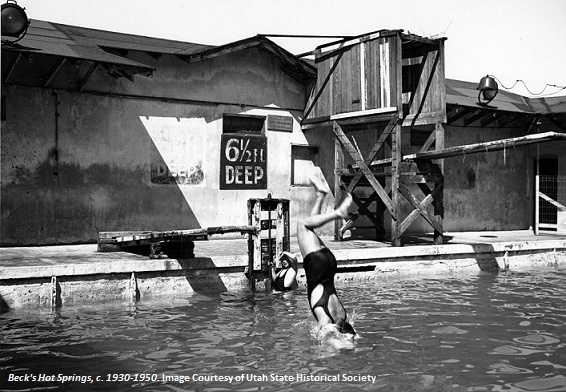Dublin Core
Title
Description
An area now occupied by an oil refinery, a gravel mine, and a freeway, was once Salt Lake’s premier tourist attraction.
Everyone smells it. A whiff of sulfur, as your car rounds the corner on I-15 between Salt Lake and Davis Counties. Nowadays, the smell of stagnant pools of mineral water might be considered an insult to the senses, but in the late 1800s, these hot springs attracted locals and tourists alike.
Thermal hot springs are common in the Great Basin, and those in Salt Lake Valley were noticed by early pioneers. Orson Pratt noted in July 1847 the “great numbers of hot springs” heavy with salt and sulfur and boiling temperatures. Just four miles north of Salt Lake City was the largest of these – the Wasatch Warm Springs and the nearby Hot Springs Lake. The new settlers frequently bathed there and by 1850 had built swimming pools, a dining room, and a dance hall. Warm Springs became a popular camping spot for people traveling into the city, and by 1865, mule trains brought residents to the baths.
Many people thought mineral springs provided extraordinary cures. In an 1871 tourist guide, the transcontinental railroad promoted Warm Springs for its healing waters, and travelers soon detoured there for the health benefits. In 1885, a resort called Beck’s Hot Springs was built adjacent to Warm Springs and became known as the “Sanitarium of the West.” An 1886 newspaper article hailed the waters as having healing benefits for dyspepsia, diabetes, and skin disease. The article quoted a Mrs. Barnes from the eastern United States, who claimed to be cured from her chronic rheumatism after visiting Beck’s Hot Springs.
To accommodate tourists, hotels and pools were built and a dedicated railroad line made regular trips to the hot springs. But by the 1930s, demand for the healing waters faded and the resorts eventually closed, ironically, for health reasons.
So the next time you smell that sulfur, remember – it is a remnant of Utah’s “fountain of youth.”
Creator
Heidi Orchard for Utah Humanities © 2014
Source
Image: Beck's Hot Springs. Photo of Beck's Hot Springs Resort in the North Salt Lake area, 900 North 200 West. c. 1930-1950s. Courtesy of Utah State Historical Society.
_______________
See Lutz, Susan Juch, “Cleaned up and cleaned out: Ruined hot spring resorts of Utah,” GHC Bulletin, December 2004, Energy and Geoscience Institute, University of Utah, accessed http://geoheat.oit.edu/bulletin/bull25-4/art3.pdf; Divett, Robert T., Medicine and the Mormons, National Center for Biotechnology Information, accessed at http://www.ncbi.nlm.nih.gov/pmc/articles/PMC197931/pdf/mlab00186-0032.pdf; Kaysing, Bill, Great Hot Springs of the West: Revised and Expanded, Santa Barbara, CA: Capra Press, 1990; “Beck’s Springs,” The Daily Enquirer Newspaper, April 23, 1886, vol. 10, no. 33, accessed at http://udn.lib.utah.edu/cdm/compoundobject/collection/de1/id/101631/show/101656/rec/40; Pearce, Louise B., Salt Lake City’s Vanishing Hot Springs, 1953, Utah State History, MSS A 1690; Tullidge, Edward William, The History of Salt Lake and Its Founder; Union Pacific Railroad and Central Pacific Railroad, Crofutt’s TransContinental Tourist’s Guide, New York: George A. Crofutt, 1872.
Publisher
The Beehive Archive is a production of Utah Humanities. Find sources and the whole collection of past episodes at www.utahhumanities.org
Date
2014-08-22

